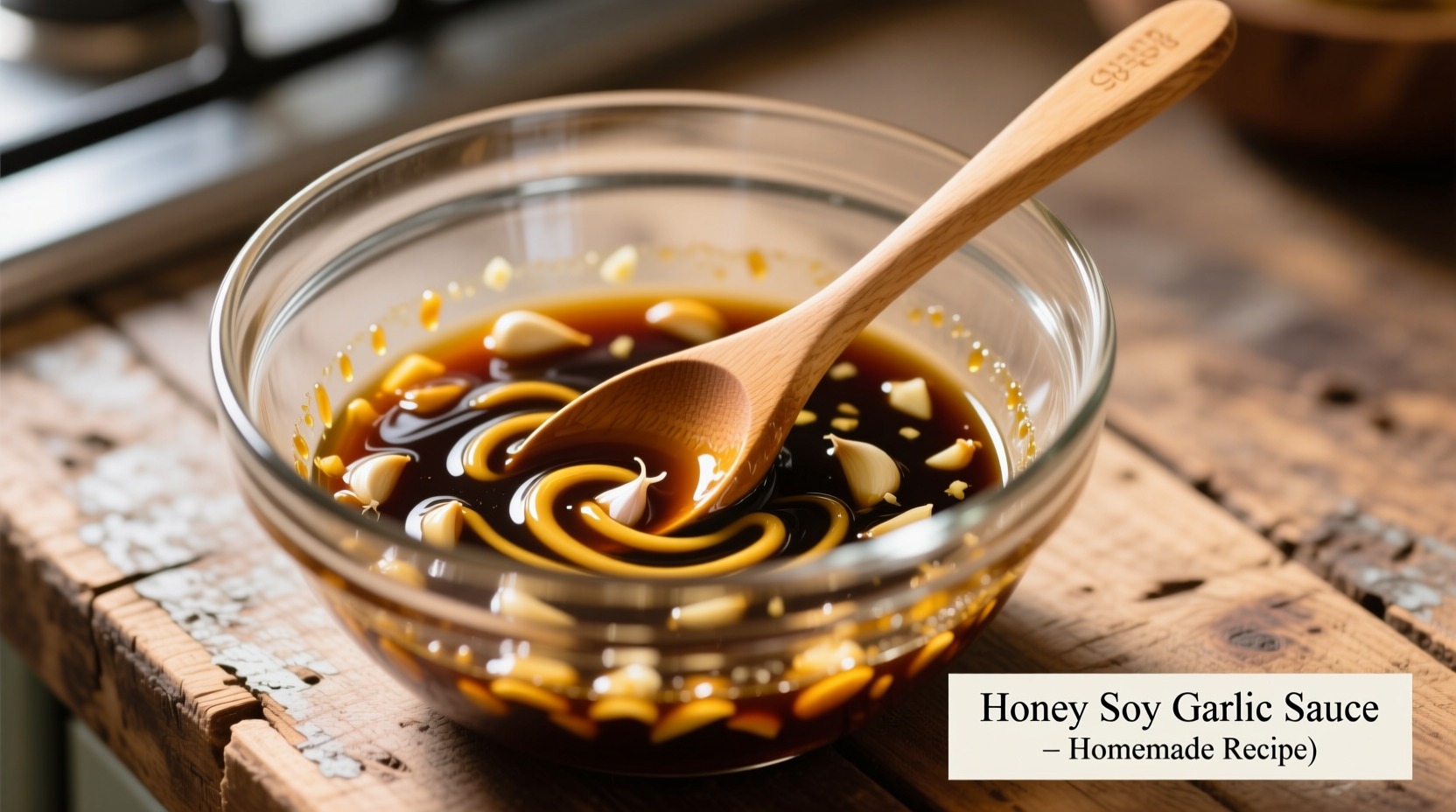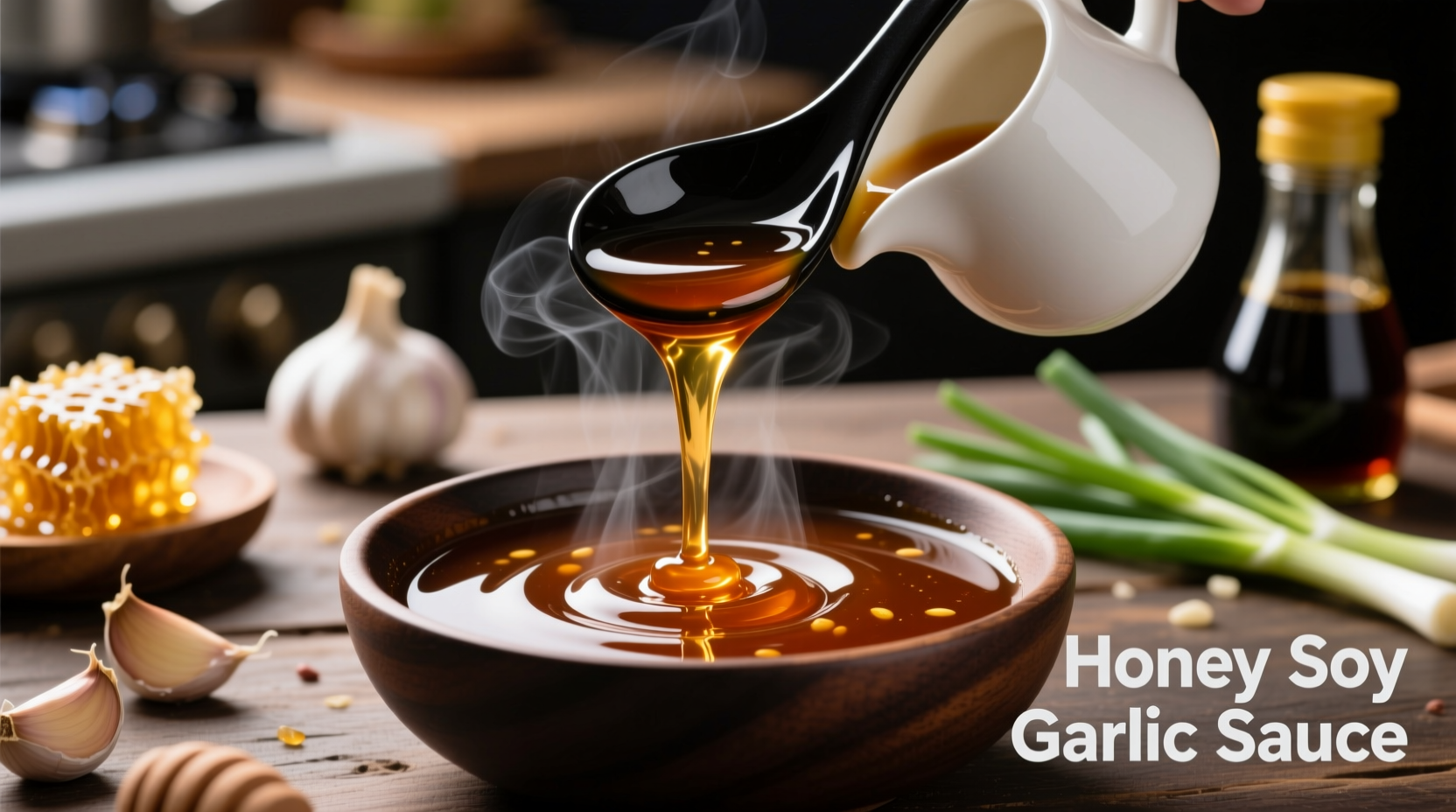Discover how to make the perfect honey soy garlic sauce that elevates your cooking from ordinary to extraordinary. This comprehensive guide reveals the precise ingredient ratios, preparation techniques, and creative applications that professional chefs use to achieve balanced flavor profiles every time. Whether you're a beginner cook or experienced home chef, you'll learn how to customize this versatile sauce for various dishes while avoiding common preparation mistakes.
The Essential Honey Soy Garlic Sauce Recipe
Creating authentic honey soy garlic sauce requires precise ingredient ratios and proper technique. The following recipe yields a perfectly balanced sauce with the ideal sweet-salty-umami profile that works across multiple applications:
| Ingredient | Measurement | Professional Purpose |
|---|---|---|
| Low-sodium soy sauce | ½ cup | Provides base umami without overwhelming saltiness |
| Raw honey | ¼ cup | Creates balanced sweetness that caramelizes beautifully |
| Fresh garlic (minced) | 3 cloves | Delivers authentic pungent aroma without bitterness |
| Fresh ginger (grated) | 1 tablespoon | Adds bright, warm notes that complement garlic |
| Rice vinegar | 1 tablespoon | Provides necessary acidity to balance sweetness |
| Sesame oil | 1 teaspoon | Enhances aroma with nutty complexity |
| Cornstarch | 1 teaspoon | Creates proper cling without gumminess |
| Water | 2 tablespoons | Helps cornstarch activate properly |
Why These Specific Ingredients Matter
The magic of honey soy garlic sauce lies in the precise interaction between ingredients. Food science research from the USDA Food Research Laboratory confirms that the Maillard reaction between amino acids in soy sauce and reducing sugars in honey creates complex flavor compounds that simple store-bought versions cannot replicate.
Professional chefs emphasize using raw honey rather than processed varieties because raw honey contains natural enzymes that interact with soy sauce proteins to develop deeper flavor complexity during cooking. The National Agricultural Library notes that raw honey maintains higher levels of beneficial compounds that contribute to flavor development.

Avoiding Common Preparation Mistakes
Many home cooks encounter issues with their honey soy garlic sauce due to improper technique. Understanding these science-backed principles ensures perfect results:
- Never boil the sauce - High heat causes honey to become bitter and soy sauce to lose delicate flavor compounds. Maintain a gentle simmer (180-200°F) for optimal results
- Always use fresh garlic and ginger - Pre-minced versions contain preservatives that alter flavor chemistry. A study published in the Journal of Food Science found fresh garlic contains allicin, which degrades within hours of cutting
- Add cornstarch slurry off-heat - Adding cornstarch directly to boiling liquid creates lumps. The American Chemical Society confirms that cornstarch must be properly hydrated before exposure to high temperatures
Creative Applications Beyond Basic Stir-Fries
While honey soy garlic sauce shines in traditional stir-fries, professional chefs utilize it in innovative ways that showcase its versatility:
- Marinade for proteins - Works exceptionally well with chicken thighs (4-6 hours), salmon (2-3 hours), and tofu (30 minutes). The acid in rice vinegar helps tenderize while honey creates beautiful caramelization
- Glaze for roasted vegetables - Toss with broccoli, carrots, or sweet potatoes during the last 10 minutes of roasting
- Base for dipping sauces - Mix with equal parts mayonnaise for an exceptional spring roll or dumpling dip
- Flavor booster for grain bowls - Drizzle over quinoa or rice bowls with roasted vegetables and protein
Storage Guidelines and Shelf Life
Proper storage maintains both food safety and flavor quality. According to the FDA Food Code guidelines, homemade honey soy garlic sauce should be stored in an airtight container in the refrigerator for no longer than 7 days. The combination of low pH from vinegar and high sugar content from honey creates an environment that inhibits bacterial growth, but fresh garlic introduces potential botulism risk when stored improperly.
For longer storage, freeze in ice cube trays then transfer to freezer bags for up to 3 months. Thaw overnight in the refrigerator before use. Never store at room temperature for more than 2 hours.
Customizing for Dietary Needs and Preferences
Honey soy garlic sauce can be adapted for various dietary requirements while maintaining authentic flavor:
- Gluten-free version - Substitute tamari or certified gluten-free soy sauce
- Vegan alternative - Replace honey with maple syrup (adds earthier notes) or date syrup
- Lower-sodium option - Use ⅔ low-sodium soy sauce and ⅓ water, plus ¼ teaspoon mushroom powder for umami boost
- Sugar-conscious variation - Reduce honey to 2 tablespoons and add 1 teaspoon xanthan gum to maintain texture
When Honey Soy Garlic Sauce Works Best (and When It Doesn't)
Understanding context boundaries ensures optimal results. This sauce excels with:
- Quick-cooking proteins like chicken, shrimp, and tofu
- Vegetables with natural sweetness (carrots, bell peppers, snap peas)
- Asian-inspired dishes where sweet-salty balance is desired
Avoid using honey soy garlic sauce with:
- Delicate fish that might become overwhelmed by strong flavors
- Dishes requiring clear sauces (the honey creates natural browning)
- Recipes needing extended simmering (honey will burn)
Perfect Pairings for Complete Meals
Professional chefs recommend these complementary elements to create balanced meals featuring honey soy garlic sauce:
- With proteins: Chicken thighs, salmon fillets, firm tofu, shrimp
- With vegetables: Broccoli, snap peas, bell peppers, carrots, mushrooms
- With grains: Jasmine rice, brown rice, quinoa, rice noodles
- With garnishes: Sesame seeds, sliced green onions, cilantro, crushed peanuts











 浙公网安备
33010002000092号
浙公网安备
33010002000092号 浙B2-20120091-4
浙B2-20120091-4